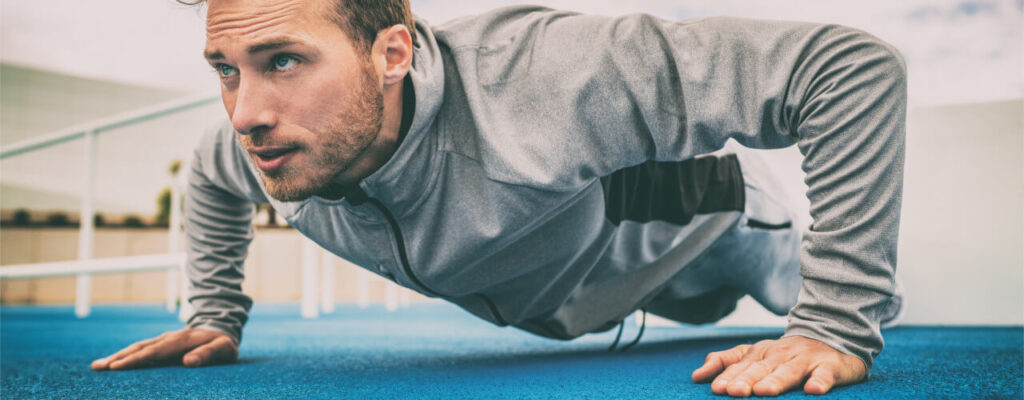Bodyweight Training

It’s More Powerful Than You Think

Written by Anthony Pinto Da Costa, BA Kin, MScPT
Registered Physiotherapist
Ah, the wonderful world of bodyweight training. Such an effective method of training that is often overlooked largely due to its simplicity. However, what many of us don’t realize is that sometimes the simplest methods of training can give us the most powerful results.
In this blog post, we’re going to go back to the basics, as I talk to you all about the power of bodyweight training. I’ll first open up by defining bodyweight training, while also telling you some of its upsides. From there, I’ll move into unraveling the common misconception surrounding this method of training. Finally, I’ll go over some limitations of bodyweight training, as well as some suggestions on how you can incorporate it into your training regimen.
Let’s dive right in.

What is Bodyweight Training?
Bodyweight training refers to any exercise that involves using the body as a means of resistance to perform work against gravity. In other words, it consists of moving your body through space against a naturally occurring force.
Some of the common bodyweight exercises are as follows:
- Pull-ups
- Push-ups
- Dips
- Squats
- Planks
- Sit-ups
- Jumping
Collectively, the above exercises set the foundation for bodyweight training. Nonetheless, this list is by no means exhaustive. Hundreds of variations and progressions can be stemmed from each exercise to form an incredibly diverse catalogue of movement patterns for you to try out.
Take the push-up, for example. If the standard push-up gets too boring for you, you can try positioning your hands closer together and then proceed to do some narrow-based push-ups. Conversely, you can place your hands wide apart to trial some wide-based push-ups. If those options start to get mundane, you can challenge your power-generating capacity by banging out a few clapping push-ups. And finally, once two hands isn’t fun anymore, the one-arm push-up is always an option. See where I’m going here?
Aside from providing exercisers with an infinite amount of exercise variations to choose from, there are a host of other advantages of bodyweight training.
The Pros of Bodyweight Training
Bodyweight training can be advantageous in many ways:
- It helps you build more relative strength than weight training can. Relative strength refers to your ability to move a load as a percentage of your bodyweight. This type of strength requires a tonne of core stability/activation, as well as joint stabilization. As a result, you’ll develop much more control and awareness of your own body.
- It can be done anytime, anywhere. The best things in life are free. No gym membership or fancy equipment is required for bodyweight training. Just push that coffee table to the side and there you go… you have yourself a home bodyweight training gym!
- It fits your unique body structure. Have you ever tried adjusting a machine at the gym to properly fit your body position, but even after multiple attempts it just doesn’t feel right? This can happen, as it’s pretty much impossible to build an exercise apparatus that can accommodate everyone’s physical structure. However, with bodyweight training, you won’t run into that problem. Since exercises are done in open space, your limb length, unique movement pattern, and comfort level will all be accommodated for.


- It allows you to strengthen multiple muscle groups at once. This is because most bodyweight exercises are closed kinetic chain exercises, meaning your hands or feet are anchored/fixed in space during the movement. These types of exercises typically strengthen multiple muscle groups at once, giving you the best bang for your buck (in exercise dollars, I suppose).
- It is fun and fulfilling. Some people (myself included) find it more satisfying to learn a new skill or movement pattern that they’ve been working on for a while, as opposed to hitting a new personal weight record on the bench press. With hard work and dedication, bodyweight training affords you the opportunity to do some pretty spectacular things with your body, which can be incredibly satisfying to an exerciser.
Amidst the multitude of pros of bodyweight training, a negative – and falsified for that matter – narrative surrounding the effectiveness of bodyweight training still lives on, unnecessarily. Let’s debunk that.
“You Can’t Build Muscle And Strength With Bodyweight Training!”

Probably the most common misconception associated with bodyweight training is that it does not allow you to build any appreciable gains in muscle mass or strength. Many see it as a good option to keep fit and active, but not as one that can help you pack on some muscle. The accepted viewpoint is that these gains are only achievable through weight training.
I’m here to tell you today that this couldn’t be further from the truth.
Both weight training and bodyweight training can help you build size and strength, and they do so through the exact same mechanisms. Communicating the universal language to our muscles is what ultimately triggers these mechanisms.
Our Muscles Only Understand One Language

As I just mentioned, the mechanisms that control improvements in muscle size and strength are always the same. That’s because our muscles only understand one language: Stress.
The concept is simple: If you apply enough stress to your muscles, nervous system, and connective tissues, your body will adapt to this stress by improving in muscle size and strength. This is known as the S.A.I.D. principle, which stands for Specific Adaptation to Imposed Demands.
Given that, your muscles only understand and respond to the stresses placed upon them regardless of the implement that’s responsible for causing the stress. In other words, whether you load your muscles with external weights or your own bodyweight, your muscles will adapt to the stress in the same way.
It’s not like our muscles go, “Oh yeah, that’s probably a dumbbell in their hand” when you’re doing a bicep curl – all it understands is that it’s somehow under stress.
With all that said, over time our muscles will become accustomed to the stress we put on them, which will result in no further growth. In order to continue our quest for gains, we must gradually apply more stress overtime; this is known as progressive overload.
With weight training, progressive overload is achieved by slightly increasing the amount of weight you’re lifting. Seems pretty easy, right?
But what about bodyweight training? How do we add more stress without adding more weight? What do we do when 10 push-ups becomes too easy for us?
The answer to that may be a concept some of us learned back in high school physics.
Manipulating Leverage

If we added external load to a bodyweight exercise, such as doing weighted pull-ups, it technically would not be considered bodyweight training anymore. Therefore, in order to strictly progress bodyweight training, we must do so by manipulating something called leverage.
Leverage is the exertion of force using a lever (e.g., a see-saw). Our muscles work with our bones and joints as levers to create movement. There are a couple of ways that we can alter these levers to make those movements harder, thus creating more force and stress on our muscles.
The first method to decrease leverage is by changing the position of your body. Let’s put this to the test by using a plank. If you think you’re capable, get in the standard plank position with your feet shoulder width apart and your elbows positioned underneath your shoulders. Now, stay in the same position but walk your hands forward a little bit so that your elbows are slightly above your shoulders. A little harder isn’t it? That’s because you’re changing your position to create more torque on your body, thus making the exercise tougher.
The second method to decrease leverage is to alter the length of your muscles. To further understand this concept, it’s best to use a pull-up as an example. Usually when people learn this exercise for the first time, they do what we call “half reps”; that is, they don’t go all the way down (completely straighten arms) and don’t go all the way up (completely bend arms). The reason for this is because our muscles are strongest in those mid, or “half rep,” ranges. Therefore, an easy way to make a bodyweight exercise, such as the pull-up, harder is to use the entire range of motion. That’s why I always say that 2 proper pull-ups are better than 8 “half rep” pull-ups.
Limitations of Bodyweight Training
Although I’m a huge advocate for bodyweight training, I’d be doing a disservice to you if I did not discuss some of its limitations.

- When it comes to building mass and strength in your leg muscles, weight training > bodyweight training. Plain and simple. Using bodyweight alone for the lower extremities cannot yield the same gains in size and strength that weight training can.
- Training progressions can sometimes be slow and challenging. The jump from 4 to 5 pull-ups can often times feel like it is months away from achieving. These plateaus are common and can be frustrating for an exerciser. Patience is definitely a virtue when it comes to bodyweight training. Subtle improvements require diligence and mental fortitude (speaking from experience here).
- It’s hard to “isolate” or bias a certain muscle/muscle group. From a training standpoint, this may or may not be an issue for you, but from a rehab point of view, this can be problematic when working with someone who has an acute injury.
Suggestions
If there’s one thing I want you to gather from reading this blog post, it’s this: Both bodyweight training and weight training have their strengths, but more importantly, they both have their limitations. Therefore, my suggestion to you, the readers, is that in order to make up for the pitfalls of both training methods, you should do both!
In my humble opinion, if we limit ourselves to one method over the other, we rob ourselves of obtaining our optimal strength, size, robustness, and resiliency. Be versatile in your methods in order to achieve the results you desire.
Below is a list of resources on how to get started with bodyweight training. Sift through these and give them a try!
Thanks for reading.
Good Quality Bodyweight Training YouTube Channels
For Those Who Have Instagram, Check These Out
- Learn The Push-Up
- Push-Up Variations
- Learn The Pull-Up
- Pull-Up Variations
- Learn The Plank
- Plank Variations
References
Harrison, J.S. (2010). Bodyweight Training: A Return To Basics. Strength & Conditioning Journal, 32(2), 52-55.
Low, S. (2016). Overcoming Gravity: A Systematic Approach to Gymnastics And Bodyweight Training (2nd Ed.). Battle Ground Creative: Houston, Texas.
Anthony is a big social media influencer for Canadian physiotherapy students, resident physiotherapists, and newly licensed physiotherapists. Give him a follow on Instagram at The Canadian Physio Student or head over to his Youtube Channel.

